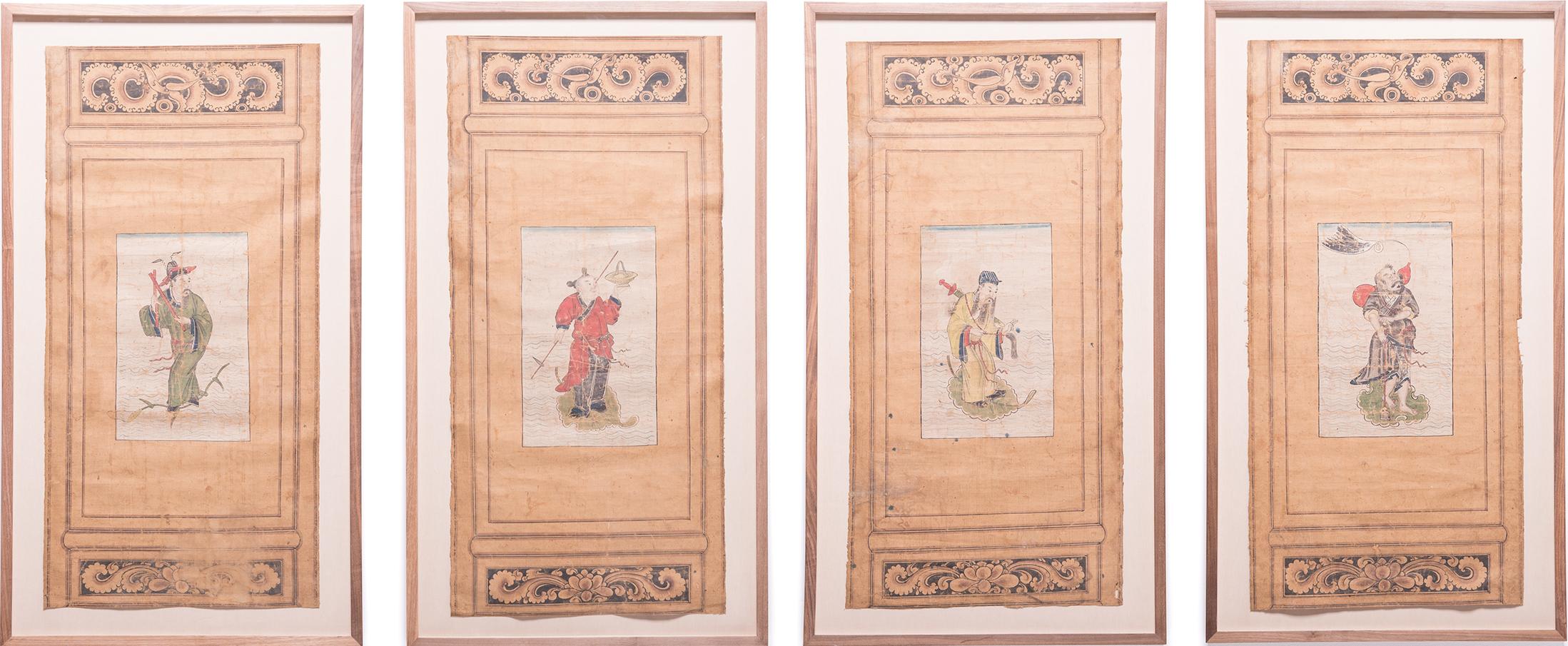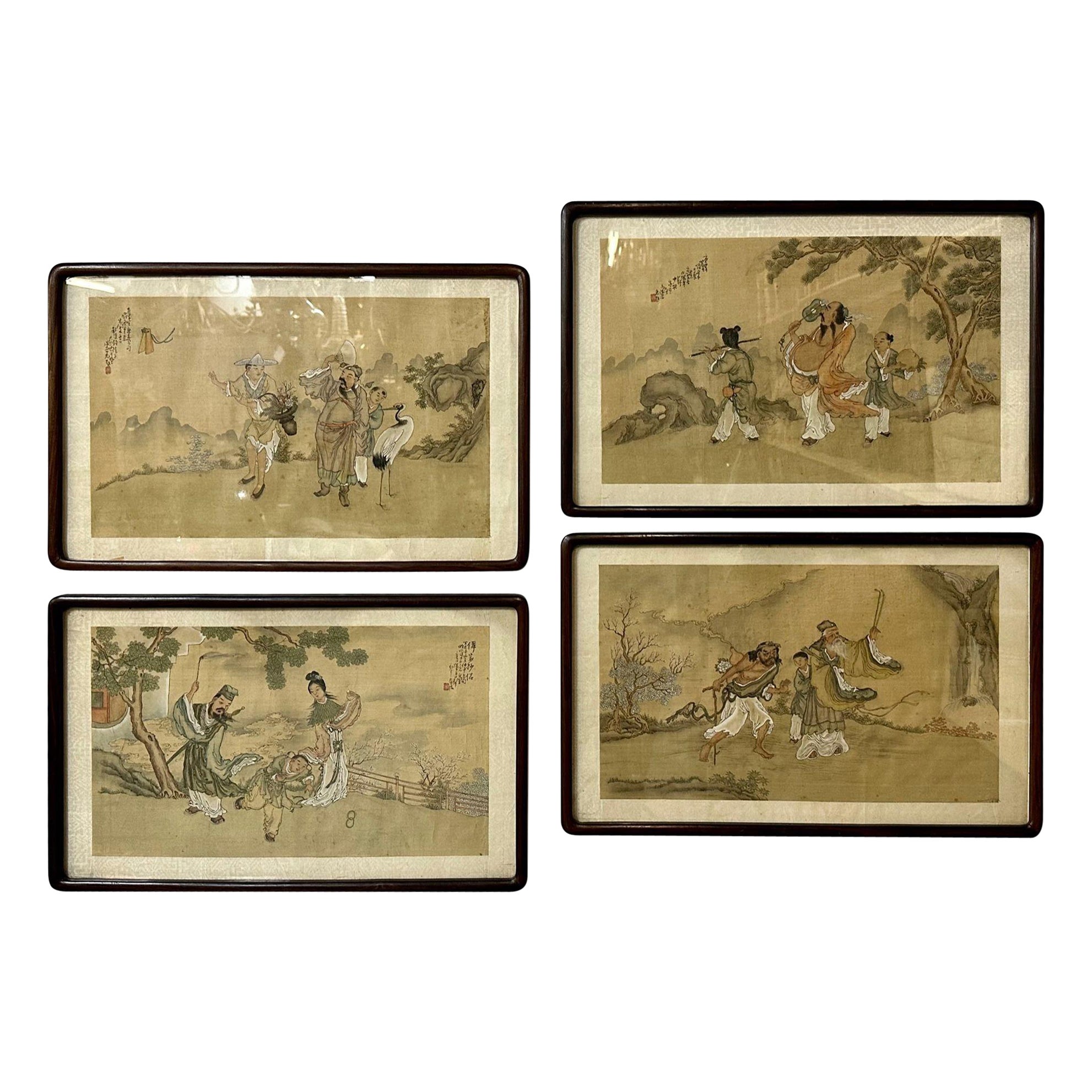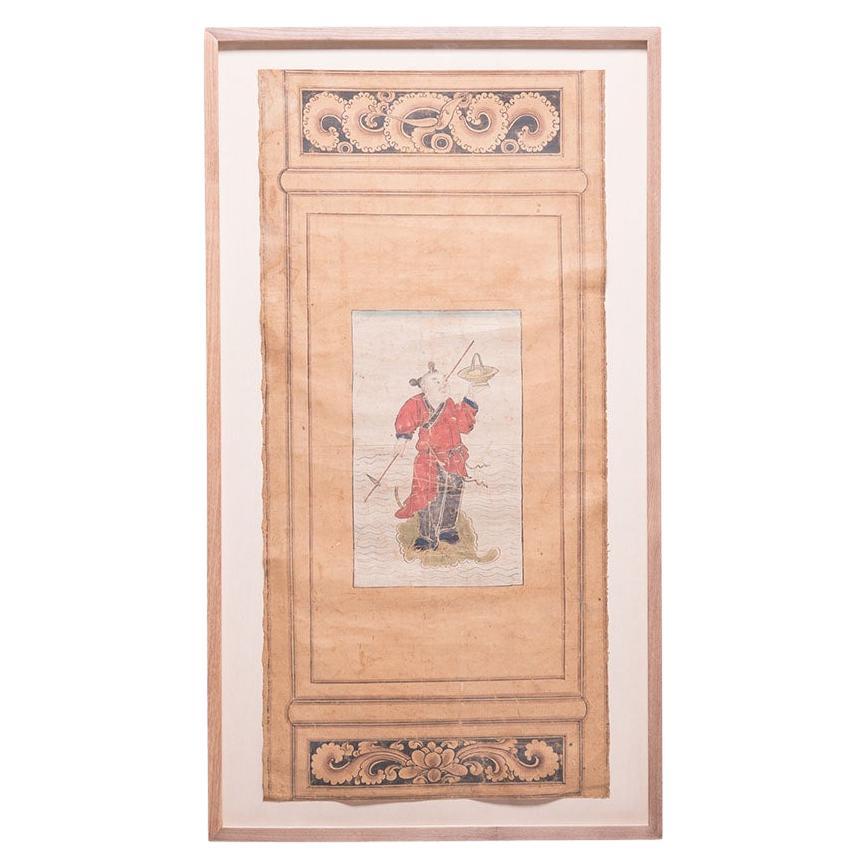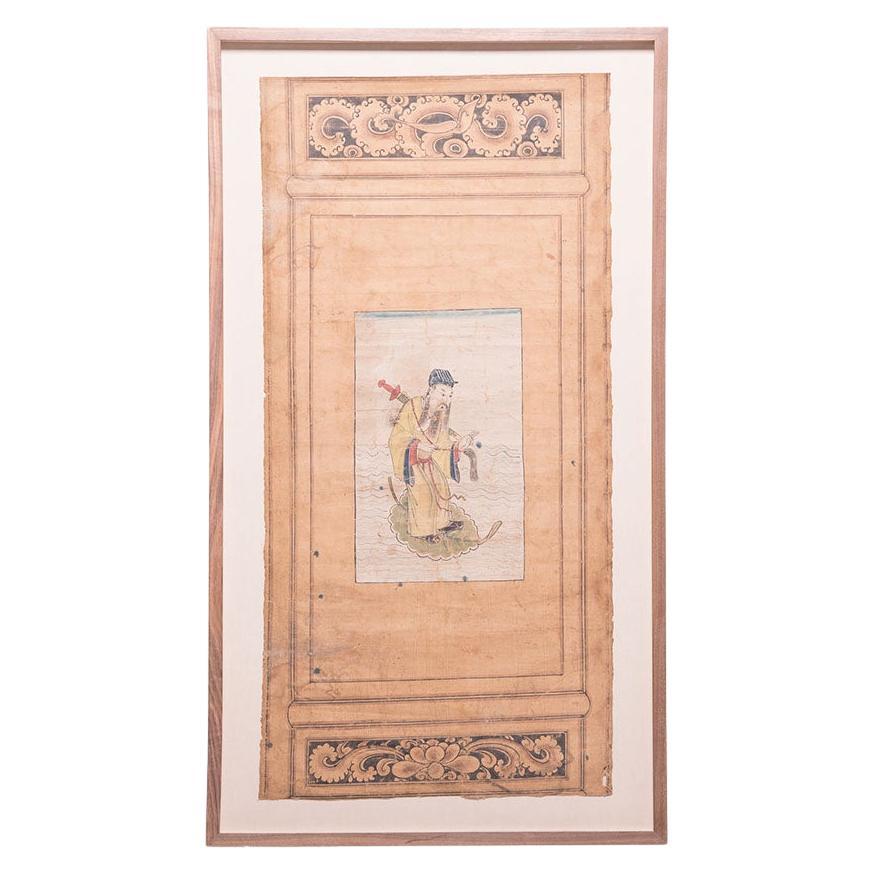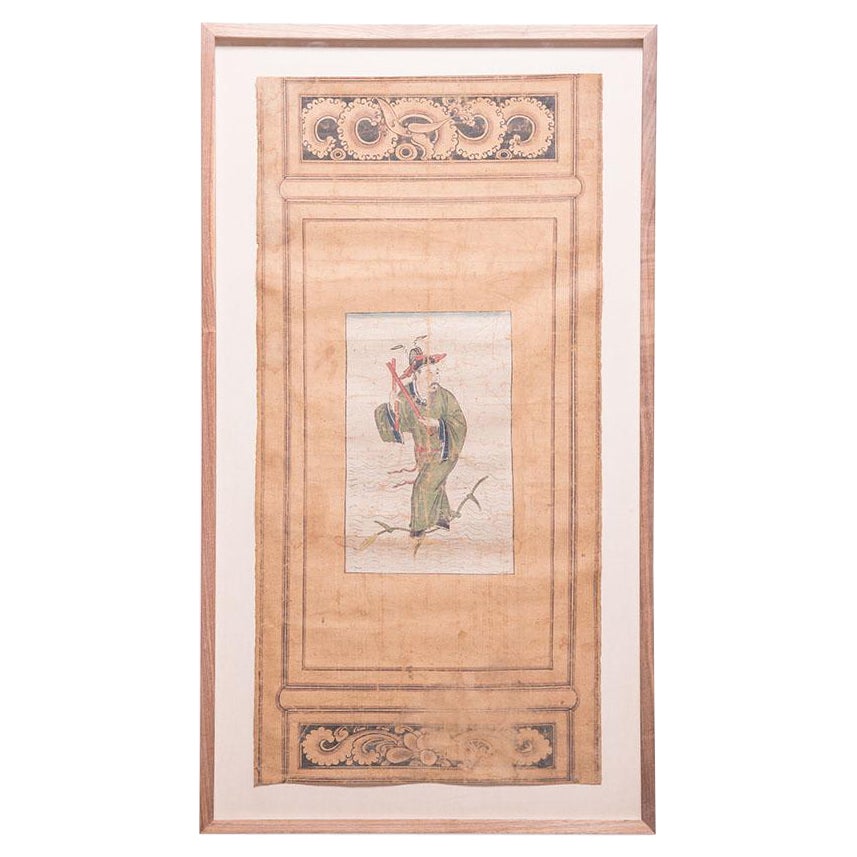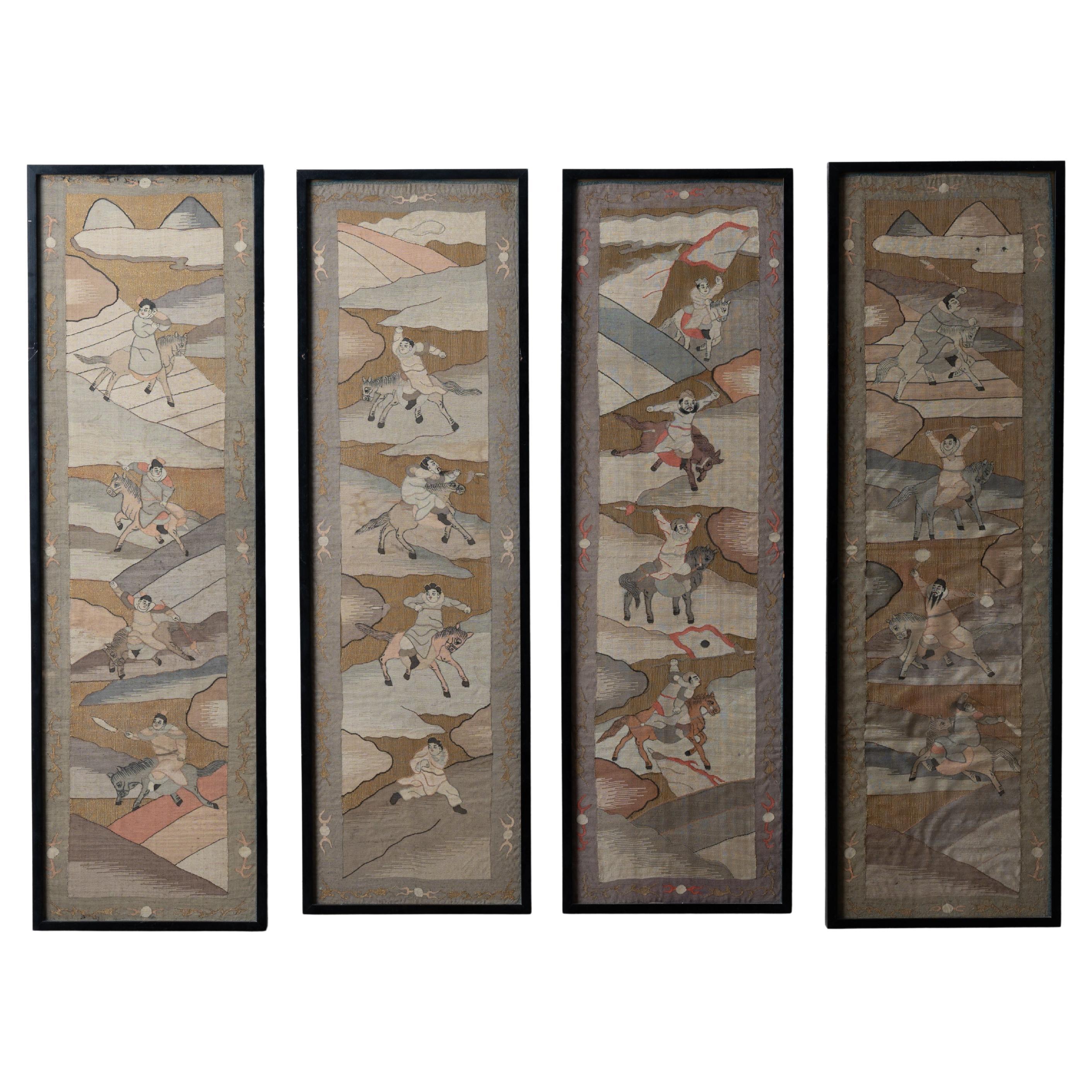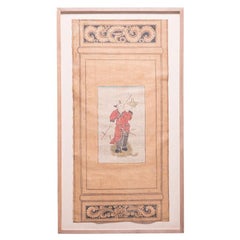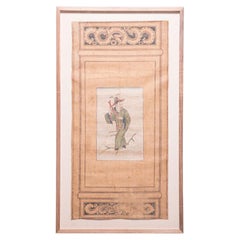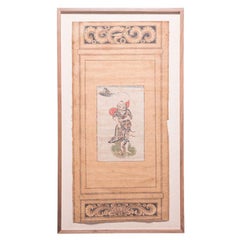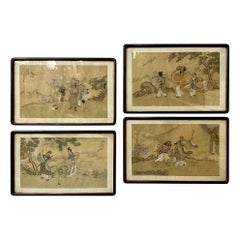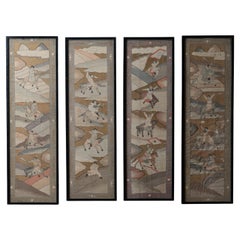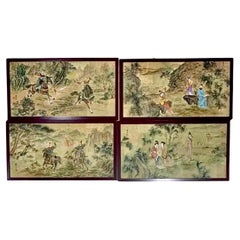Items Similar to Set of Four Chinese Immortals Screen Paintings, c. 1850
Want more images or videos?
Request additional images or videos from the seller
1 of 11
Set of Four Chinese Immortals Screen Paintings, c. 1850
$16,800per set
£12,698.72per set
€14,593.09per set
CA$23,393.90per set
A$26,024.75per set
CHF 13,642.50per set
MX$318,016.11per set
NOK 173,720.23per set
SEK 163,533.56per set
DKK 108,931.84per set
Shipping
Retrieving quote...The 1stDibs Promise:
Authenticity Guarantee,
Money-Back Guarantee,
24-Hour Cancellation
About the Item
Since the 12th century people in China have used folding screens and doors to partition and decorate their homes—the vivid scenes backing the screens added life and color to a room. These four 19th-century paintings are delicately brushed of gouache and ink on fabric and were originally part of a set of eight backing a wooden screen in northern China. The four figures depicted are four of the mythical Eight Immortals of Taoism.
Said to have attained immortality through their studies of the natural world, each of the Eight Immortals represents a different condition in life and together they impart a blessing of prosperity and longevity. Depicted here with their characteristic attire and accessories, the figures are painted with animated postures and colorful detail. The outlining brushwork imitates a wooden panel, inset with "carvings" of lotus flowers and dragons.
The four paintings are floated on linen and framed behind glass.
- Dimensions:Height: 42.25 in (107.32 cm)Width: 23.75 in (60.33 cm)Depth: 2 in (5.08 cm)
- Sold As:Set of 4
- Style:Qing (Of the Period)
- Materials and Techniques:
- Place of Origin:
- Period:
- Date of Manufacture:circa 1850
- Condition:Wear consistent with age and use. Minor losses. Minor fading.
- Seller Location:Chicago, IL
- Reference Number:Seller: Q100C1stDibs: LU820016254681
About the Seller
5.0
Platinum Seller
Premium sellers with a 4.7+ rating and 24-hour response times
Established in 1997
1stDibs seller since 2006
1,693 sales on 1stDibs
Typical response time: <1 hour
- ShippingRetrieving quote...Shipping from: Chicago, IL
- Return Policy
Authenticity Guarantee
In the unlikely event there’s an issue with an item’s authenticity, contact us within 1 year for a full refund. DetailsMoney-Back Guarantee
If your item is not as described, is damaged in transit, or does not arrive, contact us within 7 days for a full refund. Details24-Hour Cancellation
You have a 24-hour grace period in which to reconsider your purchase, with no questions asked.Vetted Professional Sellers
Our world-class sellers must adhere to strict standards for service and quality, maintaining the integrity of our listings.Price-Match Guarantee
If you find that a seller listed the same item for a lower price elsewhere, we’ll match it.Trusted Global Delivery
Our best-in-class carrier network provides specialized shipping options worldwide, including custom delivery.More From This Seller
View AllChinese Mythical Immortal Screen Painting, c. 1850
Located in Chicago, IL
Since the 12th century, people in China have used folding screens and doors to partition and decorate their homes - the vivid scenes backing the screens added life and color to a room. This 19th-century painting is delicately brushed of gouache and ink on fabric and was originally part of a set of eight backing a wooden screen in northern China.
The figure depicted is one of the mythical Eight Immortals of Taoism. Said to have attained immortality through their studies of the natural world, each of the Eight Immortals represents a different condition in life and together they impart a blessing of prosperity and longevity. Depicted here is immortal Lan Caihe, the patron saint of florists and gardeners. Standing atop a lotus leaf in open water, they hold a gardening hoe in one hand and a basket for flowers...
Category
Antique Mid-19th Century Chinese Paintings
Materials
Fabric, Paint
Chinese Mythical Immortal Screen Painting, c. 1850
Located in Chicago, IL
Since the 12th century, people in China have used folding screens and doors to partition and decorate their homes - the vivid scenes backing the screens added life and color to a roo...
Category
Antique Mid-19th Century Chinese Paintings
Materials
Fabric, Paint
Chinese Mythical Immortal Screen Painting, c. 1850
Located in Chicago, IL
Since the 12th century, people in China have used folding screens and doors to partition and decorate their homes - the vivid scenes backing the screens added life and color to a roo...
Category
Antique Mid-19th Century Chinese Paintings
Materials
Fabric, Paint
Chinese Mythical Immortal Screen Painting, c. 1850
Located in Chicago, IL
Since the 12th century, people in China have used folding screens and doors to partition and decorate their homes - the vivid scenes backing the screens added life and color to a roo...
Category
Antique Mid-19th Century Chinese Paintings
Materials
Fabric, Paint
Chinese New Year Painting, c. 1900
Located in Chicago, IL
In celebration of the lunar New Year festival, it was traditional all over China to hang special decorations. In a city called Wuqiang, local artists made lacquer scroll paintings laden with symbolism. This framed and finely rendered early 20th century folk painting from Wuqiang features an imperial court official and his family dressed in their best silks. The young boy is dressed in a wonderfully patterned yellow robe to offer Shou Xing...
Category
Early 20th Century Chinese Qing Paintings and Screens
Materials
Paper
"Scholar's Treasures" Chinese Painting, c. 1850
Located in Chicago, IL
A scroll and a small lantern depicted in this 19th century painting suggest the romantic notion of a Chinese scholar painting in the evening hours. Re...
Category
Antique Mid-19th Century Chinese Qing Paintings and Screens
Materials
Fabric
You May Also Like
Set of Four Chinese Immortals Screen Paintings, c. 1850
Located in Chicago, IL
Since the 12th century people in China have used folding screens and doors to partition and decorate their homes—the vivid scenes backing the screens added life and color to a room. ...
Category
Mid-19th Century Qing Figurative Paintings
Materials
Fabric, Ink, Gouache
Set of Four Chinese Paintings in Rosewood Frames, Signed, 19th Century
Located in Manhasset, NY
Set of Four Chinese Paintings in Rosewood Frames, Signed, 19th Century, Oil Canvas
Stunning example of Oriental works on canvas on wood. Each in a fine custom rosewood frame, matted. The set depicting a story of a band leader...
Category
Antique Late 18th Century Renaissance Paintings
Materials
Canvas, Paint
Chinese Silk Kesi Panels, 19th Century
Located in Savannah, GA
A set of four Chinese silk kesi embroidered panels, Qing Dynasty, 19th Century.
larger pair: 11 ⅞ by 38 ½ inches
smaller: 11 ½ by 37 ½ inches
Category
Antique 19th Century Chinese Textiles
Materials
Silk, Glass, Wood
$9,000 / set
Chinese Paintings in Rosewood Frames, Set of Four
Located in Bradenton, FL
19th Century Chinese Paintings in Rosewood Frames, Set of Four. Paintings depict scenes of courtly life and marital valor during the Qing Dynasty. Depicted are scenes with figures i...
Category
Antique 19th Century Chinese Chinese Export Paintings
Materials
Paper
Set of Five Antique Chinese Watercolors on Silk
Located in Palm Beach, FL
Intriguing set of five Chinese watercolor paintings on silk depicting men occupied in their trades, executed in a soft delicate technique and presented under glass in four wood frame...
Category
Early 20th Century Chinese Chinese Export Paintings and Screens
Materials
Silver Leaf
$4,100 / set
Set of 6 Large Kakemonos Japanese Mythology, 19th Century Japan circa 1800 Edo
Located in Beuzevillette, FR
Beautiful set of 6 large kakemonos from 19th century Japanese mythology.
Paper support with a canvas pasted on the paper
Wonderful set that is part of Japan's history and beliefs
When not hung, the Kakemonos are rolled up.
circa 1800 - Japan - Edo Period
A kakemono translates as "object to hang". In Japan this refers to a painting or calligraphy, most often done on silk or paper framed in a scroll that was intended to be hung on walls or in public lighting. This particular form, which allows them to be in a roll, dates back to the Tang dynasty in China (this would be related to the copying and preservation of ancient Buddhist texts). A Kami is a deity or spirit worshipped in the Shinto religion. A Yokai is a spirit, ghost, demon, or strange apparition from the creatures of Japanese folklore.
Each of these kakemonos represents a unique story:
- A kami, a Japanese deity, is shown painting a rainbow. Indeed, he performs the action with his right hand while his left hand holds a kind of basket with three pots of paint. This kami has a rather closed attitude. He is standing in a dark and tormented sky. Below this figure, 8 villagers are dressed in traditional Japanese clothes. Their faces are softened. They are not afraid of the elements made by the kami above their heads.
- A character with an unreal look is holding a kind of jar with his two hands, which he spills on human figures above. This being is floating in the air, probably a character from mythology, perhaps Susanoo. Underneath, villagers on umbrellas. They are trying to protect themselves as best they can from what is falling on them. One of them is carrying baskets with fish on her shoulders. A character in the background is thrown forward and falls.
- On this kakemono, the god Raijin, dressed in a white and blue outfit, strikes the sky with his two drum hammers to create lightning and its thunderous sound. Surrounded by Tomoe and a long red scarf, Raijin, enraged and with dishevelled hair, creates a dark and violent storm. The villagers seem frightened by this meteorological phenomenon. One of the villagers can be seen fainting in the arms of a man. This scene may seem chaotic, but Japanese legend tells us that once a field is struck by lightning, the harvest is good.
- On this kakemono, we see an unreal-looking figure holding a fan, as if he were sweeping away the bad weather, or simply producing gusts of wind. He is probably the kami of wind and air, Shina tsu-hiko. The figures below him seem surprised by so much wind. An umbrella flies away on the left, the women hold their hair and scarf, the clothes are caught in the power of the wind, there is even a woman on the ground on the bottom left.
- This Kakemono represents a short moment. This Raiju is a yokai (ghost spirit...
Category
Antique 19th Century Japanese Edo Paintings
Materials
Paper
More Ways To Browse
Antique Chinese Screens
Art Glass Room Screens
Chinese Screen Painted
Hand Painted Chinese Screen
Chinese Paper Screens
19th Century Chinese Screen
Mid Century Chinese Screen
Antique Brush Set
Used Screen Doors
Wooden Screen Panels
Antique Wooden Screen
Asian Fabric Panels
Wooden Asian Screens
Chinese Fold Screen
Chinese Folding Screen
Chinese Immortal
Wooden Folding Screen
Fabric Folding Screen
